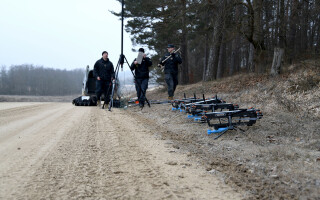Counter-UAV market heats up
StoryAugust 30, 2017
Unmanned aerial vehicles (UAVs), remotely piloted vehicles, drones, or whatever one chooses to call them are becoming more and more part of everyday life. While they provide unlimited potential in a variety of fields, they are also sparking new fears that they may be used for terrorism, drug trafficking, corporate espionage, etc. That fear in turn is firing up a new market for counter-UAV systems that will grow even faster in the commercial world.
Unmanned aerial vehicles (UAVs), remotely piloted vehicles, drones, or whatever one chooses to call them are becoming more and more part of everyday life. While they provide unlimited potential in a variety of fields, they are also sparking new fears that they may be used for terrorism, drug trafficking, corporate espionage, etc. That fear in turn is firing up a new market for counter-UAV systems that will grow even faster in the commercial world.
Counter-UAV operations are now well beyond issuing drone-hunting licenses as a resident of Deer Trail, Colorado, pushed for in 2014 only to have his ordinance shot down by his fellow residents, according to stories in the Los Angeles Times. Solutions today cost a lot more than the $25 for that proposed license.
“There are two different markets for counter-UAV technology – commercial and defense with two different types of customers focused on two different goals,” says Mike Blades, Senior Industry Analyst, Aerospace & Defense at Frost & Sullivan. “The defense focus requires systems that have multilayer detection – radar, RF [radio-frequency] scanner, electro-optical infrared for payload identification.”
An example of a multi-layered system is the Anti-UAV Defense System (AUDS) from Blighter Surveillance Systems, Chess Dynamics, and Enterprise Control Systems that uses radar; electro-optics, cameras, target tracking software, and RF jamming technology.
While a solution from IXI Technology called Drone Killer (pictured) uses RF disruption technology in the form of a gun, enabling users to essentially shoot down a UAV by jamming its signals.
Figure 1: Drone Killer.
“The military market is currently valued at about $300 to $400 million and mostly driven by U.S research, development, test, and evaluation (RDT&E) and some procurement,” Blades says. “The defense market started at about $75 million and will be right around a billion by next year, growing steadily after that. The market – including procurement and RDT&E should double by 2022.”
Lasers are also being looked at to take down UAVs.
A future game changer for defense counter-UAV systems will be directed energy, Blades says. “I think counter-UAV operations will be an early adapter of laser weapons. They will be used early on at fixed sites as they are rather large and take a lot of power. However, they also are unlimited in how many shots they take, they don’t run out of ammo, and they don’t have to worry about collateral damage in general.”
Commercial counter-UAS
“The commercial market started low,” Blades says. “There’s about 65 companies right now marketing solutions – about a quarter of them are pre-revenue. Last year the total market was about $30 million, as they just do not have a lot of contracts yet.
“The market will be closer to $100 million this year and spike six or seven times that and then drop off,” he continues. “Right now there is a lot of fear out there driving it, irrational fear. Drones will likely not be as much of a threat as people are saying. There are many horror stories about ISIS using drones to drop bombs, etc. I don’t see hundreds of drones flying around doing that in the U.S. so the commercial market may be subtly overhyped.
“The big thing with the commercial guys is having an open architecture so they can add on capability,” Blades explains. “There will also be challenges with all the FCC rules against interrupting or jamming public sector frequencies. Many of the smart companies are also taking their business overseas as they will not have to deal with as many regulations about interfering with Wi-Fi systems when they fire their jamming weapons at drones.”
The market size “has gone from ten companies to more than a 100 offering solutions,” Blades says. “Gaining in popularity are handheld systems like Drone Defender and a slew of solutions aimed at catching drones in the airspace. There have also been efforts to integrate drones into counter-UAS systems by extending their detection capability.
The counter-UAV operations also have elements of strategy and tactics like other missions.
Users are starting to focus on “countering the counter,” Blades says. “Prime contractors are looking at ways to make it more difficult to see a drone, designing anti-hackable GPS antennae, silent or low noise propellers, etc. Raytheon has developed something they call Electronic Armor to prevent drones from being hacked. It’s becoming something of a cat and mouse game, with a lot of counters to counters to counters. It’s turning into a little arms race.”






